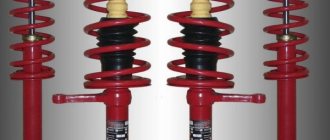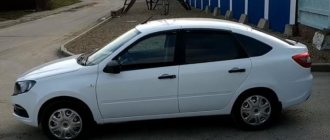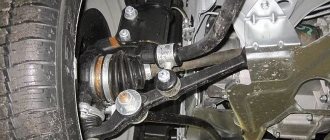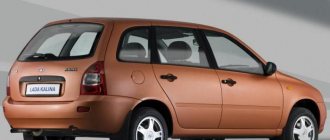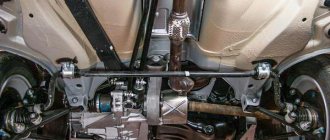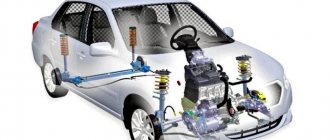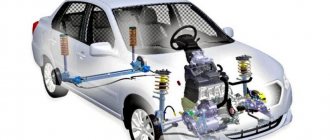An option for reducing noise or hum from wheel arches is a non-trivial method, i.e. in a way that is not usual for everyone (additional sound insulation of the arch area of the Lada Granta and Lada Kalina 2 with our own hands), we use vibration dampers. This technology for reducing structural noise is used on some business class cars.
Let's look at the design of the front suspension of the LADA Granta
. The front suspension is independent with telescopic hydraulic shock absorbers, coil springs, wishbones, two braces and a stabilizer bar. The basis of the suspension is a telescopic hydraulic shock absorber strut, which serves as a guide and load-bearing device for the front suspension. The transverse arms of the suspension are connected to each other by a stabilizer bar through struts with rubber and rubber-metal hinges.
Theoretically and experimentally, it was found that the effect of the vibration damper should most effectively be applied to the shock absorber and to the areas where the levers are attached to the body. The photo shows a vibration damper used for installation on the front suspension side member brackets and a support cup for the shock absorber spring, weighing 350 g. The dimensions are selected to optimally fit into the space. Attached to the existing front spar bracket and directly through the existing hole onto the shock absorber suspension spring cup (depending on the model and brand of shock absorber, wheel offset, tire width - through an existing hole or a newly drilled one with a diameter of 8 mm).
Appearance of the vibration damper on the front suspension shock absorber (on the left is a new-style vibration damper, on the right is an old-style damper):
Appearance of the installed vibration damper on the front spar brackets:
Vibration dampers must be used on a car with a technically sound suspension; they do not eliminate all noise, but only reduce their negative influence and impact.
List of useful accessories
for: ✔Kia Rio 3 - link; ✔Kia Rio 4 - link; ✔Hyundai Solaris - link; ✔Hyundai Solaris 2 - link; ✔Lada Vesta - link; ✔Jetta 6 - link;
The mileage at the moment is a little more than 87 thousand km, it's time to update the front suspension. The struts held the blow when hitting large holes, but on the ridge and a series of small holes it was felt that the wheels were losing contact with the road (the wheel bounces due to the fact that the shock absorbers are no longer able to dampen small vibrations), especially on the right, and there were knocks I'm pretty tired of lights out. Before compiling a list of everything needed, I considered three options: 1. Don’t change anything in the suspension, just buy everything new for the Kalina1 suspension. 2. Buy a Kalina1 stand and install a better-designed support from Granta. 3. Install both the stand and support from Granta. After much deliberation, the third option was finally chosen. Since I have a car with a 16kL engine, the so-called “barrel” spring was installed from the factory; the same ones are installed on the Grant. Below is a list of part numbers for the Grant suspension assembly. Taken from Lada Kalina Club.
Front suspension "Lada Grants"
It has an independent suspension with wishbones and a stabilizer bar. Damping of vibrations is carried out by hydraulic shock absorbers. The main structural element is the stand. It includes a swivel bearing, shock absorber and spring. The latter uses coils of variable diameter. The spring itself is made of a metal rod with a circular cross-section. It can have variable and constant hardness.
The pillar support has also been improved. Suspension creaking on the Lada Granta appears much less frequently than on Kalinas and Priors. To reduce roll, the design includes a stabilizer bar. It is made of spring steel. The stabilizer is installed with its ends to the lower suspension arms. Its middle part is fixed to the body.
Features of design solutions in the front suspension
The front suspension in the LADA Granta is based on the following aspects:
- independent design with hydraulic shock absorbers;
- a pair of wishbones;
- anti-roll bar;
- the levers are equipped with auxiliary braces;
- the spring, combined with the shock absorber into a single strut, has a conical profile and coils of variable cross-section.
The shock absorber strut is connected to the steering knuckle by a lower bracket. The design feature is that during a turn with a fist, the shock absorber and spring rotate. The scheme is very simple. This solution made it possible to preserve the technological hole in the shock absorber body, which helps to increase its service life.
The pillar supports have undergone some modifications, which made it possible to get rid of unpleasant squeaks and increase the strength characteristics of the structure.
The transverse stabilizer is based on spring steel. Its middle part is fixed to the body, both end sections are fixed to the mounting points of the transverse arms.
The modernized front suspension of the domestic Lada Granta differs from its counterpart in other representatives of the model range due to the increased steering angle of the wheels. The value of the so-called cluster reached 2° 45`. The undeniable advantage of this solution is the improvement of directional stability, especially when driving at high speeds. The other side of the coin is the slightly increased required force that should be applied to the steering wheel during a turn. If you believe the reviews of the owners, this moment is almost imperceptible.
This is due to the modernization of the steering control unit, namely:
- integration into the unit of an amplifier with an increased compensating effect;
- use of a short-throw steering rack.
This approach resulted in improved handling and resulted in a reduction in the number of steering wheel rotations. And the steering wheel itself now has more information and sensitivity.
Based on reviews from LADA Granta owners, one can judge that the designers have adopted a design solution that is strange for the modern era of automotive manufacturing - this is when a standard suspension is used and there is no power steering in the steering mechanism. Can this solution be interpreted as a way to reduce the cost of the design?
Rear suspension
Unlike the front, it has undergone virtually no changes. Here, just like on the first Soviet G8s, a semi-independent beam is used. It is attached to the body on hinges (fortunately, there are no “crabs” in the design). A helical spring with constant stiffness is used as an elastic element. To dampen vibrations and prevent swinging, two shock absorbers are used.
- High reliability. The design does not have additional levers, which, in addition, can bend when falling into a large hole.
- Energy intensity. The Lada Granta absorbs all bumps perfectly, especially if oil shock absorbers are installed at the rear.
- Cheap maintenance. Due to its simple design, this pendant can be rebuilt even with your own hands. And the cost of new rubber-metal elements is unlikely to empty the pockets of even the most stingy car owner.
The main difference between the “Grant” suspension is the wheel alignment angles.
How to find out when it’s time to change the shock absorbers on a Grant
Every car owner should know what the signs of a malfunction of this part look like, since it affects the controllability of the car, and therefore traffic safety.
When the strut stops working, the car body begins to sway when driving over bumps. This is especially noticeable at high speed when overtaking.
When rocking, the wheels may temporarily lose traction with the road surface, and when changing the trajectory of movement, this is fraught with a sudden skid. Therefore, if such symptoms are detected, you should immediately check the shock absorbers. A visual sign of a malfunction is oil leaks on the rack.
There are other symptoms:
- Dull knocks in the suspension when driving through potholes.
- When cornering, the body rolls more than usual.
- Increased braking distance - due to a large roll, the body leans forward and forces the car to move further by inertia.
- "Seasickness". Many passengers feel ill when moving, although they did not have such symptoms before.
- When rocking the car with your hands, it undergoes vibrations for some time.
After identifying faulty racks, it is necessary to replace them. Driving with faulty shock absorbers is dangerous.
Shock absorber
This element is a damping device. The shock absorber serves to reduce the range of vibrations of the car body. In other words, the element prevents spontaneous rocking. The work of the shock absorber is based on hydraulic resistance. Inside it there is a liquid of a certain viscosity. It moves through a special valve. Thus, the device absorbs sharp impacts while preserving vulnerable suspension parts. Therefore, the shock absorber is one of the most important components in the chassis. On our roads, this element lasts about 60-80 thousand kilometers. But this period may be shorter, even with careful driving. It is enough just to damage the protective boot, and all the dirt will accumulate in the rod seal.
Self-diagnosis method
For self-diagnosis, you will need the help of another person.
Having chosen a flat surface, put the car on the handbrake and remove the protective covers from the glasses.
Have an assistant rock the car to set the shock absorbers in motion, and observe the behavior of the bearing yourself. The malfunction of the unit can be judged by:
- by the presence of backlash;
- when knocking or other sounds appear in the bearing area.
Make similar observations when your partner rotates the steering wheel, and then repeat the manipulations with the second pillar.
Replacing a strut bearing requires special tools and some plumbing skills. The best option would be to entrust the work to specialists, but if you are used to doing everything yourself, then you can do it yourself, but this is a topic for another article.
In any passenger car, regardless of design, the suspension must provide a smooth ride, good handling, each element of the chassis plays its role, and there are no unnecessary spare parts. The support bearing is a part of the front suspension, without which it is impossible to imagine a front-wheel drive car; if it were not there, the steering wheel would turn very tightly, with a terrible squeak, and it would be impossible to drive the car.
Silent blocks
By 100 thousand, the silent blocks of the cross member and lower arms fail. Signs of a malfunction are a dull knock from the front suspension of the Lada Granta. Motorists recommend replacing these elements with polyurethane ones.
The silent blocks of the anti-roll bar also fail. These bushings are also replaced with polyurethane ones.
Causes and signs of failure, diagnostics
The node takes a dynamic (variable) load, and failure, as well as replacement, is usually required for several reasons:
- Part wear, time to failure (service life);
- Accidents, frequent driving in potholes, aggressive driving style;
- Contamination of the support bearing from the inside, ingress of moisture and dust;
- Malfunction of suspension (shock absorbers, springs).
The main sign that a support bearing will need to be replaced is that the Granta rattles and creaks under the hood or near the struts. This appears after 80-100 thousand kilometers, under appropriate operating conditions of the car.
The design of the “support” and the front pillar is complex; the following elements can fail:
- The entire support, including the body (rarely) - position 4;
- Support bearing (more often) – position 8;
- Rubber gaskets wear out (more often) - position 9.
It is important to know:
Attention: To decide which element needs to be replaced , you should disassemble the entire assembly, the diagram of which is presented below.
Diagnostics of support bearings
To diagnose a breakdown, do the following:
- Raise the hood, find the front supports;
- Place your hand over the knot;
- Start to strongly rock the car from bottom to top (or ask an assistant);
- If you feel a knock or hear, as well as other incomprehensible sounds, it means that there are problems. It is worth disassembling or replacing the front support mechanism.
- Watch the diagnostic video:
How to check support bearings
Cause of malfunction
The main cause of element malfunction is a violation of the boot seal. Once it starts to crack, dirt and dust will get inside. They act on the ball like an abrasive. As a result, play appears and the support begins to break on its own. Is it possible to repair it? The Lada Granta suspension is designed in such a way that the ball joints cannot be restored and must be replaced entirely with new ones.
Obvious benefits
To extend the service life of parts and reduce operating costs, it is necessary to regularly, at each scheduled maintenance, carry out diagnostics of the Lada Granta FL suspension.
Malfunctions are like diseases, the more advanced they are, the more difficult it is to cope with them. Repairing damage identified at an early stage requires significantly less effort and resources than complex repairs. This is true for any car.
Wheel bearing
This element serves for uniform rotation of the car wheels. There are 4 such bearings on the Grant. On average, their resource is 100 thousand kilometers. What are the signs of a problem? The main symptom is a characteristic hum when moving. It may get worse as the car turns. The hum can occur on either side of the car, depending on which bearing has fallen apart. The entire assembly is replaced with a new one, and it doesn’t matter whether the Lada Granta’s rear suspension or the front one. It is pressed out using a puller with special paws. Pressing takes place in a vice. It is important to maintain alignment when pressing. If a bearing is installed crookedly, it will be subjected to high loads and may fall apart after just a thousand kilometers.
Innovations in the suspension system
Despite the different types of front suspension designs used (differences depend on the configuration), the developers took measures aimed at improving the performance indicators displayed by the front suspension. So the basic version of the Lada Granta served to create a modification with a more comfortable design of both elements - the front suspension and, accordingly, the rear suspension. Modernization includes:
1. Front suspension:
- the presence of a spring with an oversized coil diameter;
- gas-filled shock absorbers;
- reinforced longitudinal brace structures;
- increase in the diameter of the transverse stabilizer bar by a significant 2 mm.
2. Rear suspension:
- reinforced springs;
- gas-filled versions of shock absorbers.
An addition to the factory tuning was improved sound insulation. Due to these upgrades, the car began to confidently hold onto the road at increased speeds - up to 150 km per hour. Now sharp maneuvers in turns and bad surfaces are not a problem for him.
How to activate the immobilizer on Grant
Roof rack for Lada Granta
What is included in the standard Lada Granta package?
Analogues of the front / rear pillars of the VAZ-2190. Price
| Name / article | Price, rub.) |
| Pilenga SHP2791O / left | from 1400 |
| Pilenga SHP2790O / right | from 1400 |
| SS20 (СС20) SS20194 (front set) | from 3100 |
| Demfi | from 1400 |
| Elastomag | from 1400 |
| HOLA SH21-270G | from 1700 – 1800 |
| HOLA SH21-270 | —/— |
| HOLA SH22-270G | —/— |
| HOLA SH22-270 | —/— |
| HOLA SH40-270G | —/— |
| HOLA SH40-270 | —/— |
| Sachs 316763 rear set | from 2500 |
| Trialli AH01510 rear | from 1500 |
| Boge 30N87A rear kit | from 2500 |
*prices as of September 19, 2018.
Some Tips for Replacing the Front Shock Absorber Upper Mount
- When disassembling, the hub nut should be loosened before you remove the wheel; if the car is already suspended on a jack, it will not be easy to move it.
- If you do not have a ball joint and tie rod remover, the steering tip can be knocked out by hitting the joint joint with a heavy hammer, the blows must be sharp and precise. Even if the tip seriously “boils” in the connection, after several attempts it will still come off.
- To make it more convenient to disassemble the shock absorber strut after removal, you can immediately (while the shock absorber is still on the car) loosen the shock absorber rod nut.
- To make the nuts and bolts easier to turn off during the next repair, it is recommended to treat the fasteners and threads with graphite lubricant during assembly.
- When removing the shock absorber assembly with the hub and steering knuckle, it is a good idea to check the condition of all suspension parts on this side of the wheel. Such diagnostics will save your money and time, because it is often discovered that along with a defective support bearing, for example, a shock absorber is also faulty, or the outer CV joint has a large amount of play.
- You need to compress the spring with ties gradually, squeezing the coils little by little on one side and the other. The spring is compressed until the upper support begins to rotate freely; too much compression of the coils is not required, and in general it is unsafe.
In general, replacing the support bearings on the front struts is quite simple; to make a replacement, you don’t have to go to a car service center; you can do the work yourself.
>
How to check the serviceability of the front strut support
The OP check is performed when the car is parked on a level surface; there is no need to hang the wheels. Diagnosis is carried out as follows:
- one of the inspection participants in the front rocks the car up and down;
- another person performs a visual inspection to see if there are any gaps.
Additionally, you can turn the steering wheel and observe the behavior of the shock absorbers, put your hand on the upper support while rotating the steering wheel or rocking the car - if there is play, you will feel it with your hand; clicks and squeaks may also be heard. Another diagnostic option is to grab the top cup protruding above the glass and try to rock it from side to side, in this case the play will also be noticeable.
Signs of a faulty support bearing may include:
- knocking in the front suspension while the car is moving;
- periodically occurring creaking while turning the steering wheel;
- crunching, knocking from the front when driving on an uneven road, for example, when driving at a railway crossing;
- tight turning steering wheel;
- instability of the car on the highway.
It is possible to accurately identify the fault only by disassembling the shock absorber struts and performing a visual inspection of the parts.
